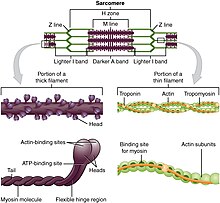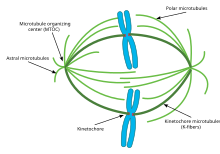User:StevieMichaels14/Motor protein

"Motor proteins"
- Kinesin, Myosin, and Dynein Illustrations:

As motor proteins that move along microtubules, kinesin and dynein have critical roles in cell division. Kinesin at the kinetochore helps in the separation of chromosomes, while cytoplasmic dynein provides the constricting force necessary to create the daughter cells during cytokinesis. 
Dynein on a microtubule - ** "Diseases associated with motor protein defects" .. Move this section down to the bottom of the page.
Diseases associated with motor protein defects[edit][edit]
[edit]The importance of motor proteins in cells becomes evident when they fail to fulfill their function. For example, kinesin deficiencies have been identified as the cause for Charcot-Marie-Tooth disease and some kidney diseases. Dynein deficiencies can lead to chronic infections of the respiratory tract as cilia fail to function without dynein. Numerous myosin deficiencies are related to disease states and genetic syndromes. Because myosin II is essential for muscle contraction, defects in muscular myosin predictably cause myopathies. Myosin is necessary in the process of hearing because of its role in the growth of stereocilia so defects in myosin protein structure can lead to Usher syndrome and non-syndromic deafness.
<<https://www.cytoskeleton.com/dynein-neurodegenerative-diseases>>
_________________________
- Connection with "Moleular motor" article --- link ??
- **Remove comment under "Cellular function" that says, "The best prominent example..." in bold below :
Cellular functions[edit][edit]
[edit]The best prominent example of a motor protein is the muscle protein myosin which "motors" the contraction of muscle fibers in animals. Motor proteins are the driving force behind most active transport of proteins and vesicles in the cytoplasm. Kinesins and cytoplasmic dyneins play essential roles in intracellular transport such as axonal transport and in the formation of the spindle apparatus and the separation of the chromosomes during mitosis and meiosis. Axonemal dynein, found in cilia and flagella, is crucial to cell motility, for example in spermatozoa, and fluid transport, for example in trachea.
| This is the sandbox page where you will draft your initial Wikipedia contribution.
If you're starting a new article, you can develop it here until it's ready to go live. If you're working on improvements to an existing article, copy only one section at a time of the article to this sandbox to work on, and be sure to use an edit summary linking to the article you copied from. Do not copy over the entire article. You can find additional instructions here. Remember to save your work regularly using the "Publish page" button. (It just means 'save'; it will still be in the sandbox.) You can add bold formatting to your additions to differentiate them from existing content. |


